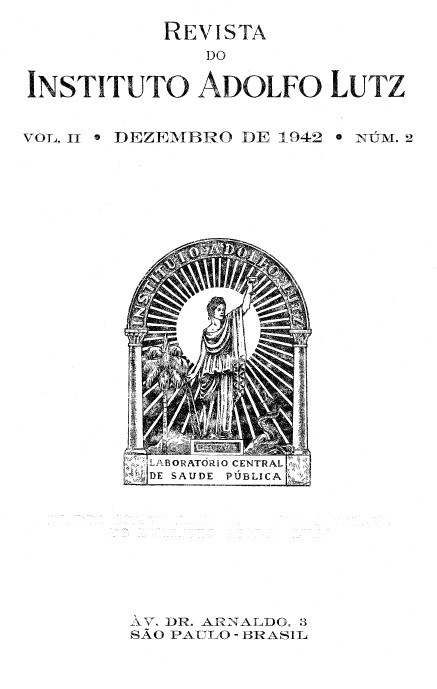Abstract
Having made a synthesis of the works published since 1911 on heterophile antibodies the authors point out the practical application of such works on the diagnosis of the infectious mononucleosis (Paul - Bunnell - Davidsohn Reaction). The authors recall the tests done by them in the Instituto Adolfo Lutz, in a effort to throw light on an epidemic proved by them to be infectious mononucleosis, which occurred in São Paulo (Brazil), this year, in April and May, and quote the official note on such epidemic published at that time by the Public Health Department. Next they report the researches on heterophile agglutinins for sheep erythrocytes which they did on the sera of a number of
lymphogranulomatosis (Disease of Nicolas-Favre) patients. Justifying their research, the authors say that amongst 76 different clinical conditions examined by various authors and in which the agglutination titres were low, there were not included cases of Nicolas-Favre diseases. Yet such disease is caused by an eminently lymphotropic virus which, therefore, affects the reticulo-endothelial systhem, as happens in the infectious mononucleosis. Testing the sera of 75 lymphogranulomatosis patients (inguinal adenitis, stenosing rectitis, etc.), all of them diagnosed clinically and allergically (Frei's Reaction), the authors met with, frequently in these sera, anti-sheeps agglutinins in high titre. Taking as positive reactions the agglutinations occurring in dilutions of 1 :112 they obtained 64% positive agglutination. And taking as positive reactions the agglutinations occurring in dilutions of 1 :224, they still obtained the expressive percentage of 41,33% positive agglutination. The highest serum dilution with positive agglutination was 1 :7168. The average titre of agglutination for the sera in lymphogranulomatosis was 1 :296. The technic was controlled with 75 normal sera out of which only 2,66% gave positive agglutination, in dilution as high as 1 :112. None gave a positive reaction with dilution of 1:224. The average positive agglutination titre for normal sera was 1 :30. Next the authors deal with the technic and the results obtained laying stress on agglutination titres met with in the sera of some of the chronically diseased patients. In 8 of such chronic cases of lyrnphogranulomatosis whose disease lasted from 1 to 15 years, agglutination was between 1 :224 and 1 :1792. Such reactions seem to indicate a slow and progressive action of the poradenic virus. Far from the authors to think that their findings might render useless the Paul and Bunnell's reaction, to which, lately, Davidsohn added the absorption test, giving it surer diagnostic value, But on the other hand they think that alongside the serum disease the hypothesis of Lymphogranulomatosis of Nicolas-Favre ought to be considered when, on performing the first phase for the diagnosis of infectious mononucleosis, we meet high agglutination titres. Usually a brief inquiry on the patients condition is sufficient to help interpretation of the laboratory tests. Besides they lay stress on the fact that, concerning the Lymphogranulomatosis of Nicolas-Favre, children are practically excluded since the disease occurs mainly between the ages of 18 and 45. Finally the authors say that they are still trying to ascertain the type of these heterophile agglutinins. For that, they have already began the absorption tests with guinea-pig kidney, ox erythrocytes and the virus itself. The results of these researches will be published later on.
References
1. - FORSSMANN, J. - 1911, Biochem. Ztschr., 37, 78.
2. - FRIEDEMANN, U. - 1917, Biochem. Ztschr., 80, 333.
3. - DAVIDSOHN, I. - 1927, Arch. of Path. nº 4, 776-806.
4. - FUKUHARA, Y. e ANDO, J. - 1914, Ztschr. f. hmn. uncl. Exp. Therap., 22, 631
5. - TROU-HIA-Hsu - 1922, Ztsch;'. f. lrmn. und Exp. Themp., 34, 507.
6. - KRITCHEVSKY, I. L. - 1923, Ztschr. f. hnrn. und Exp. Therap., 36, L
7. - FRIEDE, K. A. e GRUENBAUN, F. F. - 1925, lmmu. E,-.;p. Therap., 44, 314.
8. - KOLMER, J. A. e TOYAMA, l. - 1918, J. of lmmu., 3, 326.
9. - DEICHER, H. - 1926, Zeistehr. f. Hyg., 106, 561.
10. - DAVIDSOHN, I. ~ 1929, The Journ. of Imm., 16, 259. 1930, The Journ. of hmn., 18, 31. 1933, The Journ. of Inf. Dis., 53, 219.
11. - PAUL, J. R. e BUNNELL, W. W. - 1932, Am. Journ. of Med. Sc., 183, 90.
12. - BA.LEY, G. H. e RAFFEL, S. - 1935, J. Clin. Investigation, 14, 228.
13. - STUART, FULTON, AsH e GREGORY - 1936, Journ. Inf. Dis., 39, 70.
14. - DAVIDSOB:N, I. - 1937, The Journ. of the Amer. Med. Assoc., 108, 289.
15. - KAGAN, N. W. - 1931, Ztschr. f. hnm. u. Exp. Ther., 72, 20.
16. - STUART, C. A. e col. - 1934, Arch. of Internai Med., 54, 199.
17. - BARRETT, A. lVI. - 1941, Journ. of Hygene, 41, 330.
18. - M. BRITTO E SILVA - 1941, Revista elo Inst. Adolfo Lutz, 1, nº 1, 160.
19. - M. BRITTO E SILVA - 1942, Revista do Inst. Adolfo Lutz, 2, nº 1, 42.
20. - BUNNELL, W. W. - 1933, The Amer. Journ. of Med. Sc., 186, 346.
21. - LANDSTEINER, K., e LEVINE, P. - 1926, Journ. hmn., 12, 441.

This work is licensed under a Creative Commons Attribution 4.0 International License.
Copyright (c) 1942 Instituto Adolfo Lutz Journal
